You won’t get much change out of €50,000 for a six-year private education in Dublin these days, while sending a child to college away from home can cost about €60,000.
Add on all the grinds, Gaeltacht trips and a possible master’s that are now commonplace, and you could be looking at a small fortune to educate your children in Ireland.
It’s a lot of money, but, if your children are still young, there is a solution: start saving now.
“You know when this expense is going to happen, so you can plan for it. Planning for even a portion of it will take the pressure off,” says Grace Webster, a senior wealth executive at Goodbody. “The big thing is to start early, as the impact will be less.”
RM Block
Here are some tips on how to maximise your savings by starting early, and taking on some risk. And, for those children who don’t end up going down the college route, we have some tips on how you can transfer those college savings, tax efficiently, to be used as a deposit on a house and so on.

The Juggle: the issues facing women with young children when balancing childcare and their careers
But remember, it’s not all about the kids: you have to look after your own financial future too.
“Parents do feel pressure,” says Gwen Clarke, director of Gwen Clarke Financial Services in Kildare. “But I say to people, ‘Look after yourselves, enjoy your life. Don’t be putting aside everything you have’.”

Private school fees
It’s mainly a Dublin thing, although not exclusively: paying for private school, either at junior or senior level, or both. And, despite the obvious expense, demand is rising.
“There is definitely a big increase in people going to private or fee-paying secondary schools,” says Webster.
An Irish Times survey from late last year showed that annual fees at secondary level have climbed by up to 19 per cent, with charges for day pupils now costing €4,000-€14,000.
[ Fees have jumped across many of Ireland’s private secondary schools. Why?Opens in new window ]
Sligo Grammar School, for example, charges €4,900 a year for day fees; Alexandra College in Dublin 6 is €8,726; Belvedere College is €7,500; and Wesley College in Dublin 16 is €7,690.
So outside Dublin you could be looking at fees of €30,000, per child, for six years of secondary school, and about €48,000 in Dublin.
And this doesn’t even include those additional fees for transition year, books – remember: books aren’t free in private schools – school trips, uniforms and activities. In addition, many private schools ask for additional sizeable voluntary contributions towards future development of the facility.
Factor in private primary school and those fees will jump even more: St Andrew’s College in Booterstown, for example, charges €10,900 a year, and Lycée Français in Foxrock charges €5,610 a year.
And you will need to factor in that fees will rise from year to year. One way to hedge against such price hikes – as espoused some years ago by the Financial Times – is to ask the finance department of the school if you can pay for a number of years in advance.
The risk here is that your child won’t settle and you’ll have to move – and will you get your fees back? But the upside is that you can save money on future price increases. Of course, this is only a possibility if you have the money already salted away.
[ Carl O’Brien: Are grinds really worth it?Opens in new window ]
Even if you don’t consider private school, secondary school is expensive, with grinds, supervised study and school trips all adding to the costs.
A one-hour weekly maths grind for fifth-year students, delivered by live stream at Dublin Academy in Stillorgan, for example, costs €1,099 for the year.
Two weeks at Irish college in Uisce, Co Mayo, costs up to €1,700, while a transition year language trip to France or Spain costs several thousand euro. Living Language has a trip next spring to the west of France for €3,500 for five weeks – and air fares are extra on top of that.
Unless your children qualify for a grant (to qualify, at least in part, household earnings should be €47,010-€115,000 based on four children), you’ll be looking at a student contribution fee of up to €3,000 a year (though it was reduced to €2,000 this year), as well as all the associated living costs.
TU Dublin estimates the cost of a student living away from home will be €14,402 a year, or about €5,300 for a student living at home.
And it’s no cheaper outside the capital. University College Cork suggests a monthly cost of €1,240-€1,880 for a student living away from home in Cork – or as much as €16,920 for the academic year.

Get into the saving habit
When should you start saving? “When a child is born,” says Webster. “A great way to do it is to save [Child Benefit], if you can afford to do that, for at least 18 years.”
By starting early, you give yourself time to ride out market corrections while the positive effect of compounding on your investment over the years “can be quite substantial”, she adds. Also bear in mind that your plan should be reviewed.
And if you don’t start early, don’t despair.
“It’s never too late; as with a pension, anything at all is better than nothing,” says Clarke. “It’s a case of, set it up, and when your circumstances are better, you can save a bit more”.
Where once, many families outside urban areas bought a house or apartment to see their kids through college, Webster says this is not as common as it used to be, pointing to the sharp increase in house prices.
Instead, people are looking at saving or investing.
If ensuring you don’t lose money when saving is a priority, you will probably be looking for a regular savings deposit account.
Shop around for the best rates, as this will affect the outcome of your savings. Bank of Ireland and AIB, for example, offers a return of 3 per cent on savings of up to €30,000/€12,000 a year.
Remember that you will need to shift the balance on an annual basis, as otherwise the rate of return might plunge.
Clarke also suggests An Post, as returns are tax-free.
And even if you start with a small amount, saving over the long term can generate a decent amount. With just €50 a month, for example, you could save almost €15,000 over 18 years – enough, perhaps, for a year or two of college if the child lives away from home.
But you can potentially do better than this. In today’s environment, with interest rates so low, Webster says “you have to take a level of risk to get a level of return”. She suggests putting your money into a diversified multi-asset fund on a monthly basis. Minimum investment starts at about €100 a month.
Provided you don’t run the risk of having to encash the fund when the markets are down, you may end up doing better with your money.
Over the 10 years 2014-2024, the Standard & Poor’s 500 index of the largest American companies by stock market valuation has returned 11.01 per cent a year, or 8.87 per cent a year over the previous 20 years.
Applying a rate of return of 6 per cent, for example, means you could boost the return on your invested child benefit to almost €23,000 after 10 years.
If you’re a bit wary of the markets, you could put 25 per cent into cash, and 75 per cent into markets, says Clarke.
However, you will have to pay Dirt on anything you make on your savings. The tax applies to interest earned and is levied at 33 per cent.
When it comes to an investment fund, the tax increases to 41 per cent. Under the gross roll-up regime, this tax may be paid out after eight years, but if you consider an investment of child benefit over 10 years, earning 6 per cent a year, you would have a bill of some €2,400.

Watch out for inheritance tax
Of course, not all plans work out as envisaged.
“The children will change the plan themselves,” says Clarke, adding that some kids might opt to postpone college. If they do, the fund can remain invested.
Others won’t go at all. But the funds can still be used for something else. “If they don’t use it for college, it can be used to help them with the property market,” says Clarke.
Bear in mind that you might need to consider the possible impact of inheritance tax. Applying current tax-free thresholds, a child can inherit €400,000 tax free from their parents over the course of their lifetime.
In practice, this is often used upon death when the child inherits from the estate of the parent(s). This means that a lump-sum you save for a child’s house deposit may be liable to CAT of 33 per cent.
But there are ways around this. The small-gifts exemption allows each parent to gift a child €3,000 each – so €6,000 combined – tax free each year. Saving €3,000 from birth to the age of 18 could result in a tax-free lump sum of €54,000-€108,000.
The key, if you’re hoping to pass this gift tax free to your child, is that the money must be given to the child each year – rather than simply accounting for it at one point in time. Typically, parents will often do this by setting up a specific bank account and transferring the funds each year, or by holding the money in a bare trust for the child until they turn 18. These can be set up through institutions such as Standard Life.
If grandparents are keen to contribute to the cost of educating your children, they can also avail of this exemption.




















